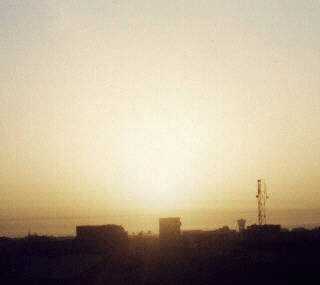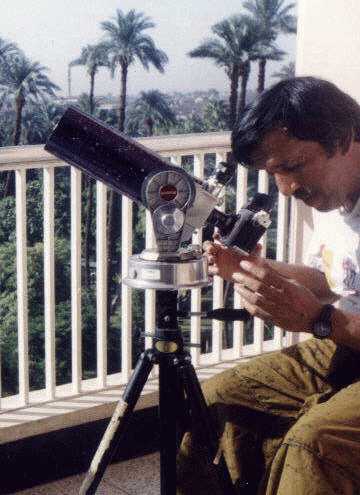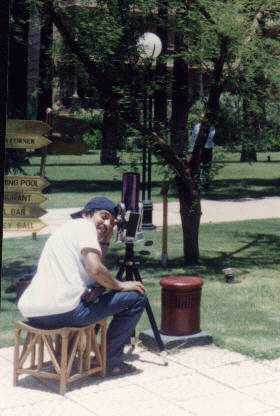Observing the
Transit of Venus across the Sun
from Luxor, Egypt.
By Kavan Ratnatunga, 2004 June 8th
To observe the rare Transit of Venus across the face of the Sun on
2004 June 8th I decided to travel to Egypt. Although the Full Transit
could be seen from South Asia or Europe, middle east particularly in
southern Egypt had the highest probability for clear sky. I had
never visited Egypt or even any other country in Africa and this was a
additional reason for the selection. Unlike for example a total
eclipse of the Sun which happens some place on earth every year, no
one currently living on Earth had seen a transit of Venus since the
last occurrence was in 1882. I didn't want to miss any of it due to
cloudy skies.
After much preparation I flew from Pittsburgh
via Amsterdam into Cairo, arriving late in the night on June 2nd at
1:15AM. The next 5 days was a fabulous trip down the Nile seeing the
many interesting Museums, Temples and Tombs. I visited the Cairo
Museum, Pyramids of Giza, the Sphinx, The Philae Temple in Aswan, Abu
Simbol, Kom-Ombo, Edfu, Luxor Karnak, etc. An great trip through 5000
years of incredible History.
On June 7th after touring the Valley of the Kings and
the Valley Queens and other monuments in the West-Bank of the Nile
I checked into the New Winter Palace hotel in Luxor. I
was given a 5th floor room with a nice view of the Nile and the Luxor
Temple.
I decided it was time to select a place with a good view of the
Eastern Horizon. There didn't seem to be one from the grounds of the
Hotel, and the roof-top had a tall wall around it obstructing any view of
the horizon. When I inquired at the reception, they said they could
open a room on the garden-side of hotel if I wanted to see
sun-rise. So I asked them to move me to such a room. They were glad to
do that since rooms on that side had less demand.
I found that the local Arabic language Newspaper had an illustrated
full page article on the Transit of Venus with interviews of Local
Scientists. I was too late to find a copy of the English Newspaper
which seems to have very limited circulation. Speaking with few
persons I saw hardly any interest. I guessed they considered the
astronomical event was something they could only watch on TV. One
person in hotel reception even warned me against looking at it. So I
guess the authorities had worked hard to encourage the public to watch
Transit only on TV.
|
I was glad I didn't have to carry the 3.5 inch Questa telescope and
other equipment early morning to setup and could observe relaxed from
the balcony of my hotel room.
That evening I went to watch the Sound and Light show in the Karnak Temple.
After returning to the hotel room I set up the equipment at night and
focused on the moon. Everything was in order. Sun Rise was around 6 AM
and the Transit started at 8:20 AM.
I woke up before the wakeup call and got
ready to photograph Sunrise before the transit of Venus. The sky
close the horizon was foggy. Although there were no clouds in the
sky, the cities in Egypt have a lot of pollution and combined with the
dusty create a fog. The night sky from the cruise ship docked in Esna
which is not a big city was no different to the sky from a major US
city like Pittsburgh on a clear night. I could only see 2nd magnitude
stars in the sky. The Sun on the horizon could be photographed without
the solar filter. The exposure indicates that the extinction at
sunrise was about the same as the 14 magnitudes of solar filter.
|

A foggy Sunrise in Luxor on June 8th
|
The Sun usually has a few sun-spots but none could be seen on that
day. It was hard to orient to know exactly where Venus would enter
the solar disk. I mounted the camera at the prime Focus behind the
mirror of the telescope so that I could both Photograph the event as
well as observe it visually through the eyepiece, needing only to
change the focus. Within a minute of the expected start time I was
able to see First contact and watched and took
photographs of the event over
the next 20 min till well past 2nd contact. The Black-drop effect was
observed briefly after 2nd contact with the region between the outer
edge of the rim of Venus and the rim of the sun being darkened like a
shadow.

Transit of Venus
photographed from Prime Focus
|

Observing from Luxor hotel balcony
|
After the disk of Venus had moved well within the Sun face, I switched
to observing through the eyepiece and Barlow which gave about 2.7
times the magnification. However at this focus it took more effort to
keep Venus within the field of view which shows only part of the
Sun-face. I mounted the camera at the eye piece mount of telescope
and took more photographs with and without the Barlow. All of the
exposures were done at one millisecond (0.001 second), the fastest
speed of the TOPCON SLR camera I was using. This was slightly
over-exposed for the Prime Focus or Eye Piece mount. It was maybe
slightly under-exposed when using the Barlow but I decide that was to
try see any detail which would get washed out in a longer
exposure. All the exposures were taken with the 12 second delay timer
on the camera to ensure any jitter from handling the camera had
dampened by the time of exposure.
When the hotel house-maid came to make the room I showed her the view
of the transit and the Arabic Newspaper so she knew what she was
looking at. She went way intrigued and told her friends and soon I had two
other hotel employees come to observe the transit.

Observing from Luxor hotel garden
|

Transit of Venus
photographed from Eyepiece mount with Barlow
|
As noon approached the Sun could no longer visible from the hotel room
balcony. Rather than go to the hot rooftop I decided to go down to the
garden of the hotel. The Sun
could be observed and with many trees around it was less hot. One of
the hotel employees I had shown the transit went and found me just the
right bench to sit down even without asking for it. The camera could
no longer be mounted at the prime Focus. I took photographs at regular
intervals with and without the Barlow.
I soon realized I had not brought down an extra roll of film. I was
reluctant to just leave the setup to get it. So when the next group of
hotel guests came to find out what I was doing, I showed them the
transit and asked them to stay and look at it while I went to get more
film. Many had heard about the transit but none had planed or expected
to see it. I know there were other groups in Luxor, but I didn't see
any. The TV did show some astronomical groups observing the transit
from Cairo, where it had not been too clear at the start of the
Transit. Cairo was often overcast on many of the few days we were
there.
Third contact was at 14:06 and end of Transit was at 14:26. The Black
drop effect was not seen maybe because the Sun was at high altitude.
I should have changed to a new roll well in advance of 3rd contact.
So took fewer closer to 3rd contact. After putting in a new roll of
film it took a few extra minutes to get the telescope pointed at the
mid day Sun. I missed taking photographs soon after 3rd contact
although I saw it while readjusting the telescope. I then decided to
just take as many
photographs as possible, as fast
as I could manually wind the film and the timer.
I had found a KODAK Film developing Shop Luxor which had the equipment
in the store. Many of the other places which accepted film for
development probably sent it to them. Although labeled 1-hour photo,
it did take a few hours to process. I decided the risk of damage to
film through all the Airport X-ray machines was significant. I had
given on the previous day a few rolls of travel photographs to print
and develop. This allowed me to ensure the quality of film developing
in this shop in Luxor was OK. Development and printing cost was also
lot cheaper than in USA. The cost was US50 cents to develop the roll
and US12 cents per 4x6 inch print. I gave the first 2 rolls to develop
and went in the horse drawn carriage to look at the Luxor
Museum. Picked up the developed Film and Prints on the way back to
hotel.
I was glad that I had got nice photographs of the Transit of
Venus across the Sun. After many years of talking about this transit,
it was now over and time to catch the evening by train to return to
Cairo.
An unexpected encounter with a Bedouin in Saqqarah gave me a chance
riding a Camel to see the Step pyramid, but that is another
story.
Venus with a diameter (6370km) slightly smaller (about 95%) of that of
Earth has a mean apparent diameter of 60 arc seconds at inferior
conjunction. The relatively thin Atmosphere (75 km) is 0.6% of the
diameter or 0.35 seconds of arc. This much less than blurring (typically
1 second of arc seeing) through the earth atmosphere. It will not be
visible through a small telescope even in ideal conditions. The
clearly visible halo around the planet seen in the perfectly focused
photographs is probably caused by diffraction.
Please follow the links, particularly click on the word photographs
to see a Javascript driven sequence of images taken near the start
and end of the transit as Venus entered and left the face of the Sun.
In Pittsburgh
where only the last hour of the six hour event was visible,
it had been sufficiently clear for
Xiaojin Zhu a graduate
Student in LTI.CS.CMU had obtained some great
images.
In Slovakia Tomas Muraska managed to
image
the International Space Station (ISS) crossing the Sun while Venus was
also in transit.




